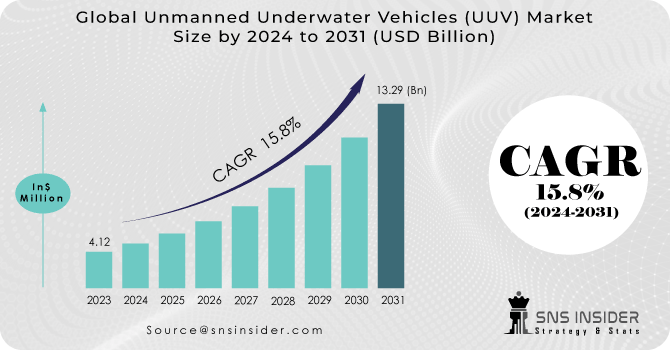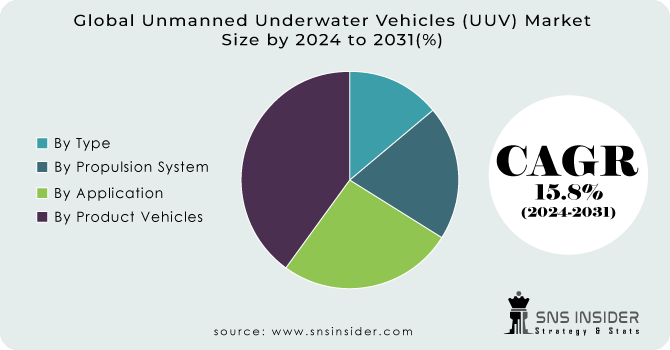Unmanned Underwater Vehicles (UUV) Market Report Scope & Overview:
The Unmanned Underwater Vehicles (UUV) Market Size was valued at USD 4.12 billion in 2023 and is expected to reach USD 13.29 billion by 2031 with an emerging CAGR of 15.8% over the forecast period 2024-2031.
Automated Submerged Vehicles are otherwise called submerged drones, are any submarine vehicles that can work submerged without human mediation. Automated Submerged Vehicles are partitioned into two sections like remotely worked submerged vehicles and independent submerged vehicles. Remotely worked submerged vehicles remotely are constrained by an individual and independent submerged vehicles are worked without human mediation. Automated Submerged Vehicles are helpful for submerged development and examination in the seaward oil and gas businesses.

To get more information on Unmanned Underwater Vehicles (UUV) Market - Request Free Sample Report
Progressions in UUV advancements, let’s say higher goal cameras, better controller arms, and more delicate sonar have decreased the time expected to find and assess things. UUV can examine the most profound water under the designs and proposition information that empowers the development business in manners at no other time. the Bluey Trailblazer is furnished with strong Drove lights, a superior quality fixed camera, and four engines that slice through low perceivability water with light-footed preparing, simple activity, and low vehicle support. UUV's can offer capacities in numerous areas especially in the readiness of battlespace notwithstanding region refusal dangers. There are a few advantages of UUV, let’s say more affordable to work, further develop efficiency, simple support, and increments exactness.
The worldwide unmanned underwater vehicle market is likely to expand as the number of naval applications for safety and security increases. Furthermore, a surge in the number of offshore oil and gas operations is likely to boost market expansion in the future. Increased monitoring activities for security, stricter restrictions, and increased government funding all contribute to the expansion of the unmanned underwater vehicles market. However, the economic crisis and defence budget cuts may have a negative impact on the unmanned underwater vehicle business.
MARKET DYNAMICS
KEY DRIVERS
-
Rising capital expenditure
-
Deep water oil & gas production rising
RESTRAINTS
-
High cost of AUV’s
-
Communication system failure
OPPORTUNITIES
-
Development of technology
-
Long battery life
CHALLENGES
-
Slow underwater survey speed
-
Deepwater pressures are really high.
IMPACT OF COVID-19
The rapid spread of COVID-19 in Europe, the United States, and Asia Pacific has resulted in a significant drop in demand for UUV globally, with a corresponding reduction in revenues for various payload suppliers and service providers across all markets due to late delivery, manufacturing shutdown, limited staff at manufacturing facilities, and limited availability of equipment. According to industry experts, global UUV demand will fully recover by 2022.
The market for unmanned underwater vehicles market is segmented into two parts: autonomous underwater vehicles and remotely operated vehicles. This has the highest CAGR over the forecast period. Autonomous underwater vehicles have shown tremendous promise in underwater activities. These autonomous programmable robots are used for underwater survey missions such as identifying and mapping submerged wrecks, rocks, and impediments. AUVs can operate in difficult-to-reach places and offer precise data since they are outfitted with cutting-edge payloads.
The remotely operated vehicle market has been divided into four applications: commercial exploration, strong defense, scientific research, and others. During the forecast period, the commercial exploration segment of the unmanned underwater vehicle market is predicted to develop the most. ROVs are used for a variety of commercial purposes, including survey and seabed mapping, offshore drilling, pipelining, cabling, and inspection, among others.
The market is divided into Mechanical, Electric, Hybrid, and Others based on Propulsion System. During the forecast period, the electric segment of the global unmanned underwater vehicles market is predicted to develop at the fastest CAGR. This vehicle can function without the use of a complicated support system. During the projection period, the mechanical segment is also predicted to increase at a rapid pace.
The market is divided into small vehicles, work-class vehicles, high-capacity electric cars and many more. Because of rising consumer purchasing power and increased use in applications for observing water column features, monitoring, and benthic zones, tiny vehicles dominated the market.
KEY MARKET SEGMENTATION
By Product Vehicles
-
High-capacity Electric Vehicles
-
Work Class Vehicles
-
Heavy Work Class Vehicles
-
Man portable
-
Light Weight Vehicles
-
Heavy Weight Vehicles
By Application
-
Commercial Exploration
-
Defense
-
Scientific Research
-
Miscellaneous
By Type
-
Remotely Operated Vehicle
By Propulsion System
-
Mechanical
-
Electric
-
Hybrid

Need any customization research on Unmanned Underwater Vehicles (UUV) Market - Enquiry Now
REGIONAL ANALYSIS
North America is expected to be the greatest market for unmanned underwater vehicles. The United States is the largest developer around the world, exporter operator, and user of UUVs, which is likely to drive market projection in North America. Thus, the increasing applicability of ROVs in the defence and commercial sectors is expected to boost the expansion of the North American remotely operated vehicle market. The primary driver of the North American autonomous underwater vehicles market is the rising usage of autonomous underwater vehicles for deep water surveys for the oil and gas industry that would otherwise be costly.
REGIONAL COVERAGE:
-
North America
-
USA
-
Canada
-
Mexico
-
-
Europe
-
Germany
-
UK
-
France
-
Italy
-
Spain
-
The Netherlands
-
Rest of Europe
-
-
Asia-Pacific
-
Japan
-
south Korea
-
China
-
India
-
Australia
-
Rest of Asia-Pacific
-
-
The Middle East & Africa
-
Israel
-
UAE
-
South Africa
-
Rest of Middle East & Africa
-
-
Latin America
-
Brazil
-
Argentina
-
Rest of Latin America
-
KEY PLAYERS
The Major Players are SAAB Seaeye, International Submarine Engineering, BAE Systems, Bluefin Robotics, Boston Engineering Corporation, Teledyne Technologies, Atlas Elektronik, Kongsberg Gruppen, Lockheed Martin Corporation, Oceaneering International Inc. and Other Players
Bluefin Robotics-Company Financial Analysis

| Report Attributes | Details |
|---|---|
| Market Size in 2023 | US$ 4.12 Billion |
| Market Size by 2031 | US$ 13.29 Billion |
| CAGR | CAGR of 15.8% From 2024 to 2031 |
| Base Year | 2023 |
| Forecast Period | 2024-2031 |
| Historical Data | 2020-2022 |
| Report Scope & Coverage | Market Size, Segments Analysis, Competitive Landscape, Regional Analysis, DROC & SWOT Analysis, Forecast Outlook |
| Key Segments | • By Product Vehicles (High-capacity Electric Vehicles, Work Class Vehicles, Heavy Work Class Vehicles, Man portable, Light Weight Vehicles, and Heavy Weight Vehicles) • By Application (Commercial Exploration, Defense, Scientific Research, and Miscellaneous) • By Type (Remotely Operated Vehicle and Autonomous Underwater Vehicle) • By Propulsion System (Mechanical, Electric & hybrid) |
| Regional Analysis/Coverage | North America (USA, Canada, Mexico), Europe (Germany, UK, France, Italy, Spain, Netherlands, Rest of Europe), Asia-Pacific (Japan, South Korea, China, India, Australia, Rest of Asia-Pacific), The Middle East & Africa (Israel, UAE, South Africa, Rest of Middle East & Africa), Latin America (Brazil, Argentina, Rest of Latin America) |
| Company Profiles | SAAB Seaeye, International Submarine Engineering, BAE Systems, Bluefin Robotics, Boston Engineering Corporation, Teledyne Technologies, Atlas Elektronik, Kongsberg Gruppen, Lockheed Martin Corporation, Oceaneering International Inc. |
| DRIVERS | • Rising capital expenditure • Deep water oil & gas production rising |
| RESTRAINTS | • High cost of AUV’s • Communication system failure |

